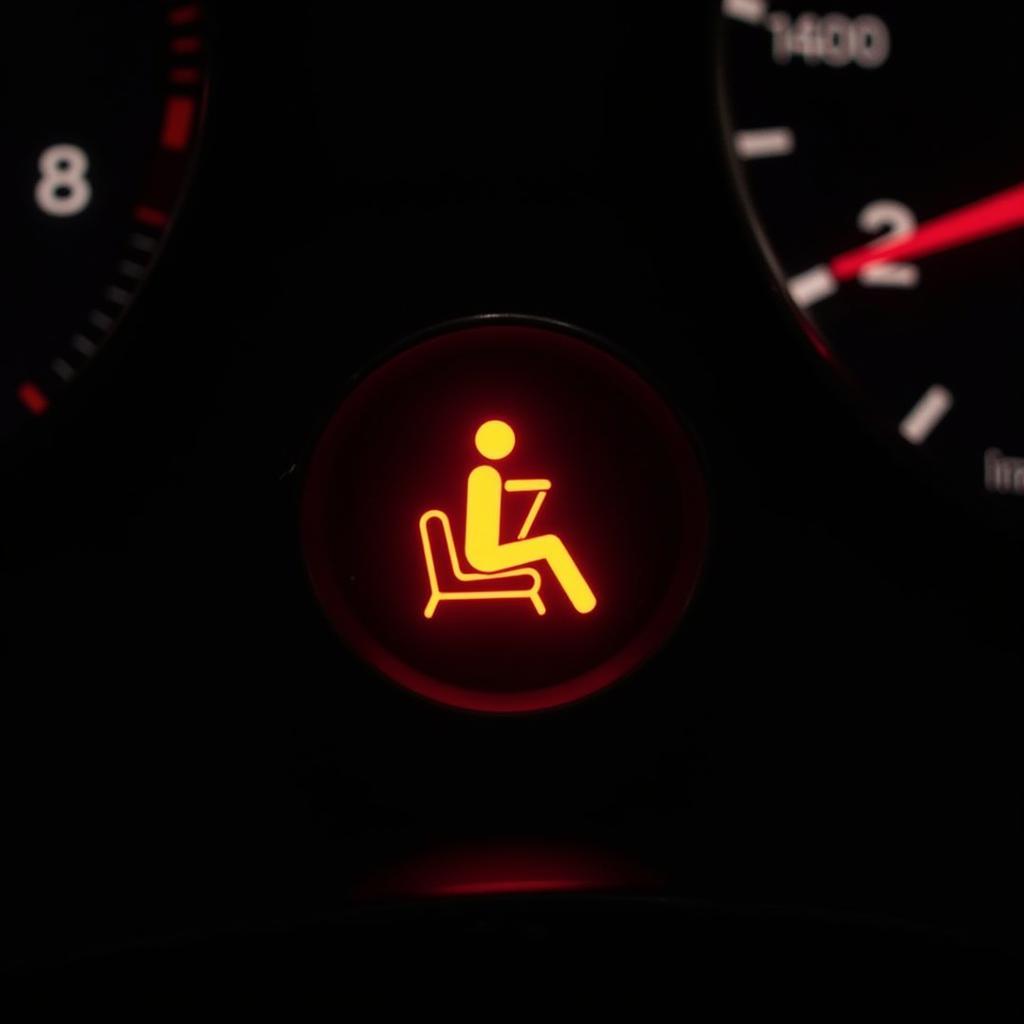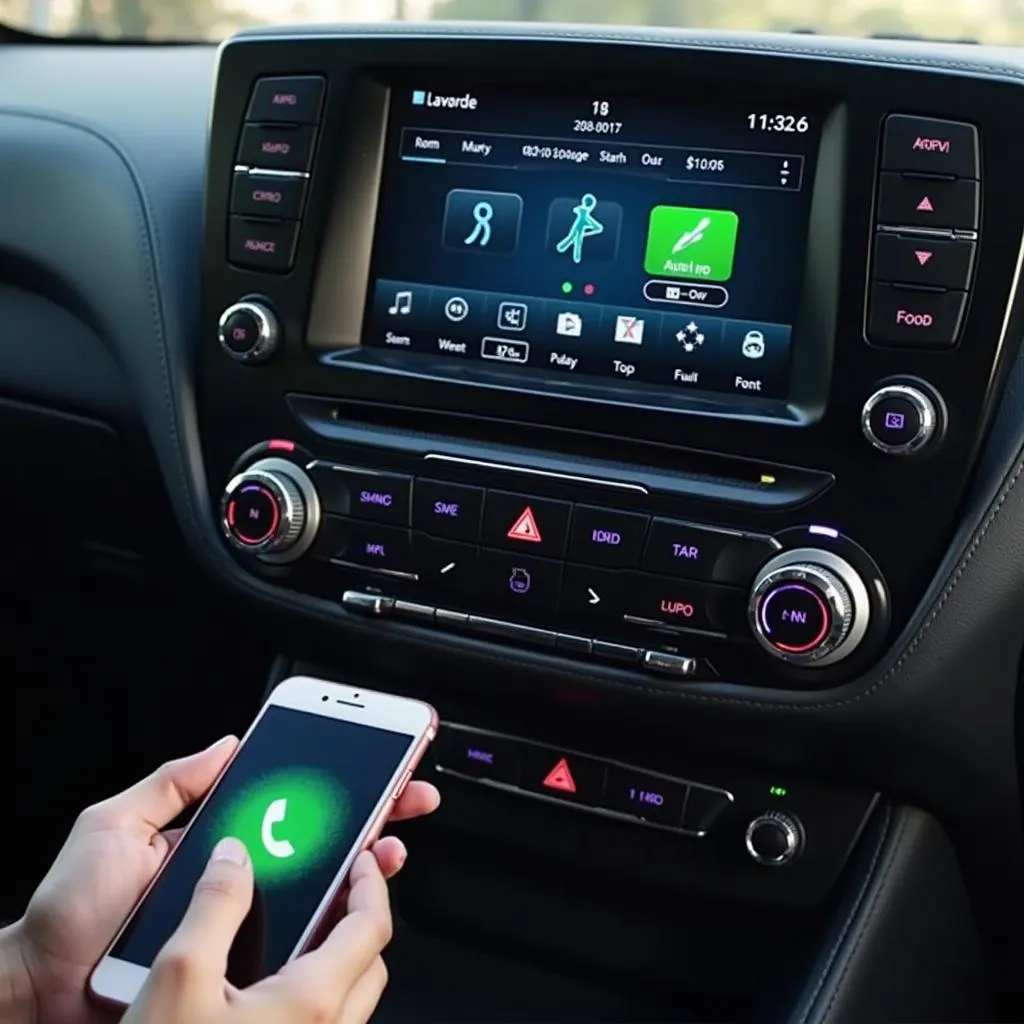The “Nissan seat belt warning light” is a common safety feature designed to keep you and your passengers safe. However, sometimes this light can come on or malfunction, causing confusion and concern. This article will explore the reasons behind this warning light, how to address it, and when to seek professional help.
Understanding the Nissan Seat Belt Warning System
Modern Nissan vehicles are equipped with a sophisticated seat belt warning system that goes beyond a simple dashboard light. It incorporates sensors, chimes, and in some cases, even visual displays to encourage seat belt usage. Here’s how it works:
- Weight Sensors: Most Nissan models have weight sensors built into the passenger seats. These sensors detect the presence of a passenger and activate the warning system if the seat belt is not fastened.
- Buckle Sensors: These sensors, located in the seat belt buckles, detect when the buckle is engaged, signaling the system to turn off the warning light and sound.
- Warning Chimes: A series of beeps or chimes will sound if the driver or a passenger is unbuckled while the vehicle is in motion. The frequency and duration of these chimes may vary depending on the Nissan model.
- Dashboard Warning Light: The most noticeable element is the illuminated seat belt warning light on your dashboard. It usually features an image of a seated figure with a seat belt across their lap.
- Advanced Displays: Some newer Nissan models might display messages on the instrument cluster or infotainment screen, providing more specific information like which seat is unbuckled.
Why is My Nissan Seat Belt Warning Light On?
There are several reasons why your Nissan’s seat belt warning light might be on or malfunctioning. Here are some of the most common causes:
- Unbuckled Seat Belt: This is the most obvious reason. If you or a passenger haven’t fastened your seat belts, the warning light and chime will activate.
- Faulty Seat Belt Buckle: A damaged or malfunctioning buckle sensor can send incorrect signals to the system, causing the warning light to stay on even when the seat belt is fastened.
- Problem with the Weight Sensor: If the passenger seat weight sensor is faulty, it might incorrectly detect weight or no weight at all, leading to a continuous warning light, even if the seat is empty.
- Electrical Issues: Wiring issues, a blown fuse, or a malfunctioning control module related to the seat belt system can cause erratic behavior in the warning light.
- Software Glitch: Like any computer system, your car’s software can experience glitches. A software malfunction within the seat belt warning system can lead to false warnings.
 Nissan Dashboard with Seat Belt Warning Light
Nissan Dashboard with Seat Belt Warning Light
Troubleshooting a Nissan Seat Belt Warning Light
Before rushing to a mechanic, there are a few troubleshooting steps you can try yourself:
- Check the Obvious: Ensure all passengers, including yourself, have fastened their seat belts properly. Double-check that the buckles are clicked in securely.
- Inspect the Buckles: Visually inspect the seat belt buckles for any signs of physical damage, dirt, or debris that could be interfering with the sensor. Try cleaning the buckles gently with compressed air.
- Check the Connections Under the Seat: With the engine off, carefully inspect the wiring connections under the passenger seat. Look for any loose or damaged wires. If you feel comfortable, try unplugging and re-plugging the connectors to ensure a good connection.
- Reset the System: Disconnecting your car battery for a few minutes can sometimes reset the vehicle’s electrical system and potentially resolve a software glitch. Remember to consult your owner’s manual for the correct battery disconnection procedure.
When to Seek Professional Help
If the troubleshooting steps haven’t resolved the issue, it’s best to seek professional help. A qualified Nissan mechanic or dealership can diagnose the problem accurately using diagnostic tools. They can identify if the issue lies with the seat belt buckle, weight sensor, wiring, or software, and advise on the necessary repairs or replacements.
Here are some situations where seeking professional help is highly recommended:
- The warning light remains on even after trying the troubleshooting steps.
- You suspect a faulty seat belt buckle or weight sensor.
- You’re uncomfortable dealing with electrical components or potential software issues.
Tips for Preventing Seat Belt Warning Light Issues
- Regular Inspection: Make it a habit to visually inspect your seat belt buckles and the area around the passenger seat for any signs of wear, damage, or debris.
- Keep it Clean: Dirt and grime can accumulate in the buckles, affecting the sensors. Use a vacuum cleaner or compressed air to clean them periodically.
- Avoid Placing Heavy Objects: Avoid placing heavy objects on the passenger seat, especially when unoccupied. This can put unnecessary stress on the weight sensor and potentially lead to malfunctions.
Expert Insight
“Many people ignore a persistent seat belt warning light, assuming it’s just a sensor glitch. However, it’s crucial to address the issue promptly. Not only can a malfunctioning seat belt system be a safety hazard, but it can also affect the deployment of your airbags in case of an accident.” – David Miller, Senior Automotive Technician
Conclusion
The seat belt warning light in your Nissan is a critical safety feature. Understanding how it works and addressing any issues promptly can ensure your safety and the safety of your passengers. While some troubleshooting steps can be performed at home, don’t hesitate to seek professional help if the problem persists. Remember, a properly functioning seat belt system is paramount for your safety on the road.
FAQs
1. Can I disable the seat belt warning chime in my Nissan?
While it’s technically possible to disable the chime in some models, it’s highly discouraged. The chime serves as a crucial reminder for you and your passengers to buckle up, ensuring your safety.
2. Does the seat belt warning light affect my airbag deployment?
In some cases, yes. A malfunctioning seat belt system can interfere with the proper deployment of airbags, potentially increasing the risk of injury during an accident.
3. How much does it cost to fix a Nissan seat belt warning light issue?
The cost can vary significantly depending on the root cause. A simple buckle replacement might be relatively inexpensive, while a faulty weight sensor or wiring harness repair could be more expensive.
4. How often should I get my seat belts inspected?
It’s recommended to have your seat belts inspected by a qualified mechanic at least once a year or as part of your regular vehicle maintenance schedule.
5. My 2017 Nissan Rogue warning light is on with an unoccupied seat. What should I do?
This could indicate a faulty weight sensor. You can try cleaning the area around the sensor and see if it resolves the issue. If not, it’s best to take your Rogue to a Nissan dealer or a trusted mechanic for diagnosis and repair. You can find more information about the 2017 Nissan Rogue seat belt issue in this article: 2017 nissan rogue warning light on with unoccupied seat.
6. The seat belt warning sound in my Nissan Rogue is not working. What could be the problem?
Several factors could cause this, such as a malfunctioning speaker, wiring issues, or a software glitch. For a detailed guide on troubleshooting this issue, you can refer to our article on Nissan Rogue seat belt warning sound not working.
7. Does the 2016 Nissan Altima have an audible seat belt warning?
Yes, the 2016 Nissan Altima is equipped with both visual and audible seat belt warnings. If you’re experiencing issues with the audible warning in your Altima, you can find more information in our article: does the 2016 altima have an audible seat belt warning.

